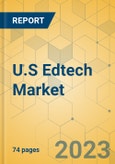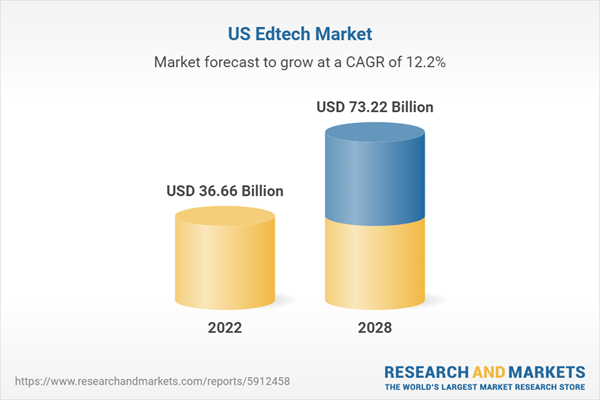Speak directly to the analyst to clarify any post sales queries you may have.
KEY HIGHLIGHTS:
- The US EdTech sector has experienced substantial investment from various sources, including venture capital firms, private equity, and traditional educational institutions. Investors have recognized the transformative potential of innovative educational technologies. This surge in funding has empowered EdTech startups to develop and scale their platforms, create engaging educational content, and expand their user bases.
- EdTech platforms in the US increasingly prioritize personalized and adaptive learning experiences. These platforms use data analytics and artificial intelligence to assess individual student performance, preferences, and learning styles. This data-driven approach enables tailored content recommendations, adaptive assessments, and real-time progress tracking, ultimately enhancing the efficacy of the learning process.
- Many US governments have acknowledged the significance of digital education and initiated policies to integrate technology into classrooms. These initiatives involve investments in essential infrastructure, teacher training programs, and the developing of digital learning resources. Government support is pivotal in driving the widespread adoption of EdTech solutions within educational institutions. Collaborations between EdTech providers and government entities foster innovation and accessibility.
- Despite its growth, accessibility remains challenging in the US EdTech market. Disparities in internet access can hinder widespread adoption, but the sector has proactively addressed this issue. Nonprofits and developers are working diligently to ensure equitable access through user-friendly interfaces and low-bandwidth solutions. The commitment to inclusivity is evident as the EdTech sector collaborates with communities, provides devices, and improves internet access to ensure that learning opportunities reach all segments of society.
- In March 2023, Duolingo, one of the key vendors, launched a new subscription tier with access to an AI tutor powered by GPT-4, unlocking two new AI-powered features called “Roleplay” and “Explain My Answer.” The Roleplay feature allowed users to practice real-world conversation skills with responsive and interactive AI chatbots. The Explain My Answer feature allowed users to learn more about their responses in lessons, whether their answers were correct or incorrect. This introduction set a precedent for integrating advanced AI into language learning, potentially motivating other Edtech players to adopt similar AI-driven enhancements.
LIST OF VENDORS
Key Vendors
- McGraw Hill
- Pearson
- Chegg
- Bright Horizons
- Skillsoft
Other Prominent Vendors
- Coursera
- Duolingo
- Boxlight
- 2U
- Udemy
- Kahoot!
- Blackboard
- ApplyBoard
- VIPKid
- Brainly
- Preply
- Labster
- Great Minds
- Guild Education
- Everspring
- DreamBox
- Newsela
- Multiverse
- Elevate
- Course Hero
- GoGuardian
- Quizlet
- Outschool
- Udacity
- GoStudent
SEGMENTATION & FORECAST
Business Models (Revenue)
- Freemium Business Model
- Ad-based Revenue Model
- Free Trial & Subscription-Based Model
- Marketplace Model
- Institutional Sales Model
- Recruiting Model
Type (Revenue)
- Hardware
- Software
- Technology-Enabled Services
Sector (Revenue)
- K-12
- Higher Education
- Competitive Exams
- Certifications
End-users (Revenue)
- Individual Learners
- Institutes
- Enterprises
MARKET STRUCTURE
- Market Dynamics
- Competitive Landscape of US Edtech Market
- Key Vendors
- Other Prominent Vendors
APPENDIX
- Research Methodology
- Abbreviations
- About the Analyst
Table of Contents
Companies Mentioned
- McGraw Hill
- Pearson
- Chegg
- Bright Horizons
- Skillsoft
- Coursera
- Duolingo
- Boxlight
- 2U
- Udemy
- Kahoot!
- Blackboard
- ApplyBoard
- VIPKid
- Brainly
- Preply
- Labster
- Great Minds
- Guild Education
- Everspring
- DreamBox
- Newsela
- Multiverse
- Elevate
- Course Hero
- GoGuardian
- Quizlet
- Outschool
- Udacity
- GoStudent
Methodology
Our research comprises a mix of primary and secondary research. The secondary research sources that are typically referred to include, but are not limited to, company websites, annual reports, financial reports, company pipeline charts, broker reports, investor presentations and SEC filings, journals and conferences, internal proprietary databases, news articles, press releases, and webcasts specific to the companies operating in any given market.
Primary research involves email interactions with the industry participants across major geographies. The participants who typically take part in such a process include, but are not limited to, CEOs, VPs, business development managers, market intelligence managers, and national sales managers. We primarily rely on internal research work and internal databases that we have populated over the years. We cross-verify our secondary research findings with the primary respondents participating in the study.

LOADING...
Table Information
| Report Attribute | Details |
|---|---|
| No. of Pages | 74 |
| Published | December 2023 |
| Forecast Period | 2022 - 2028 |
| Estimated Market Value ( USD | $ 36.66 Billion |
| Forecasted Market Value ( USD | $ 73.22 Billion |
| Compound Annual Growth Rate | 12.2% |
| Regions Covered | United States |
| No. of Companies Mentioned | 30 |









